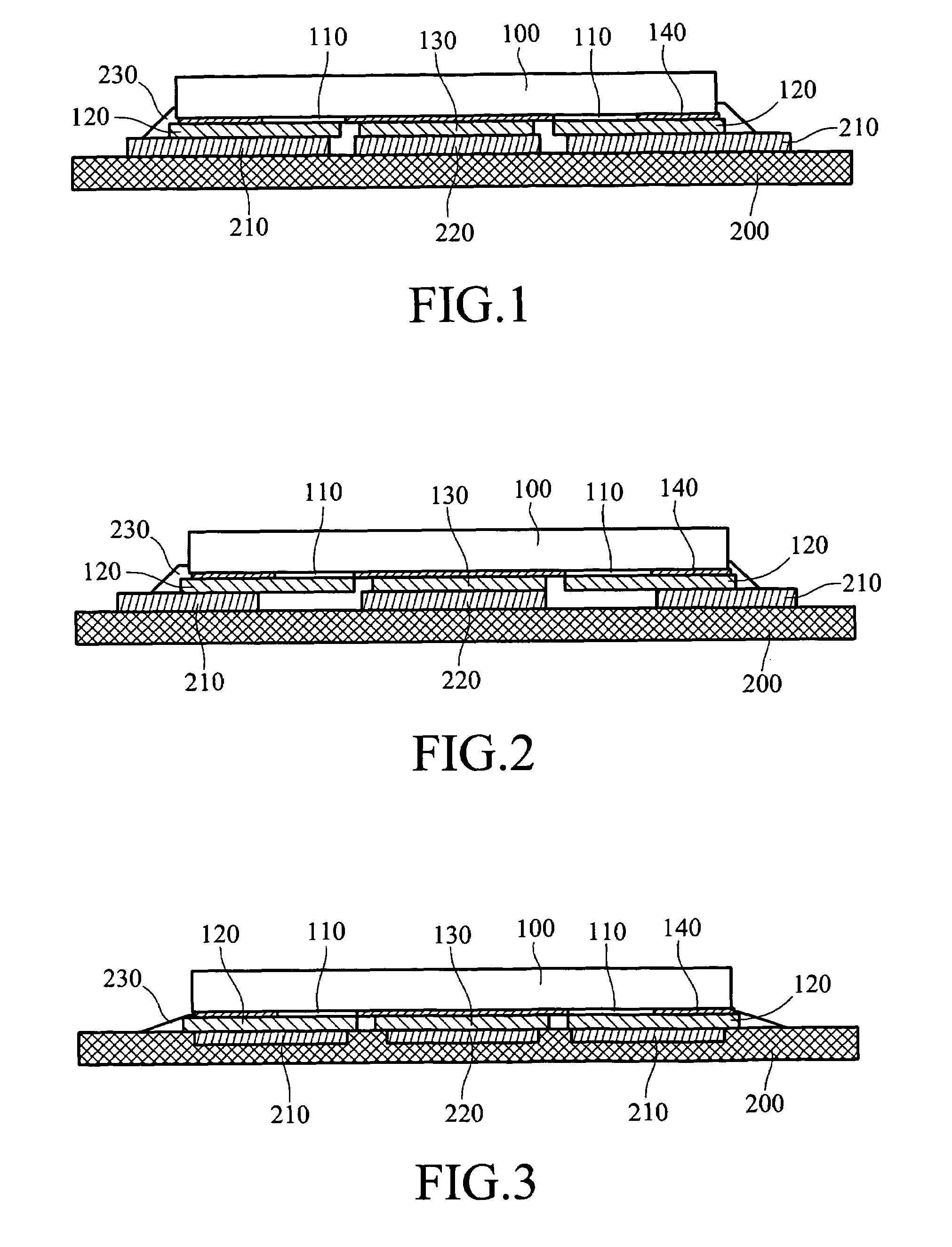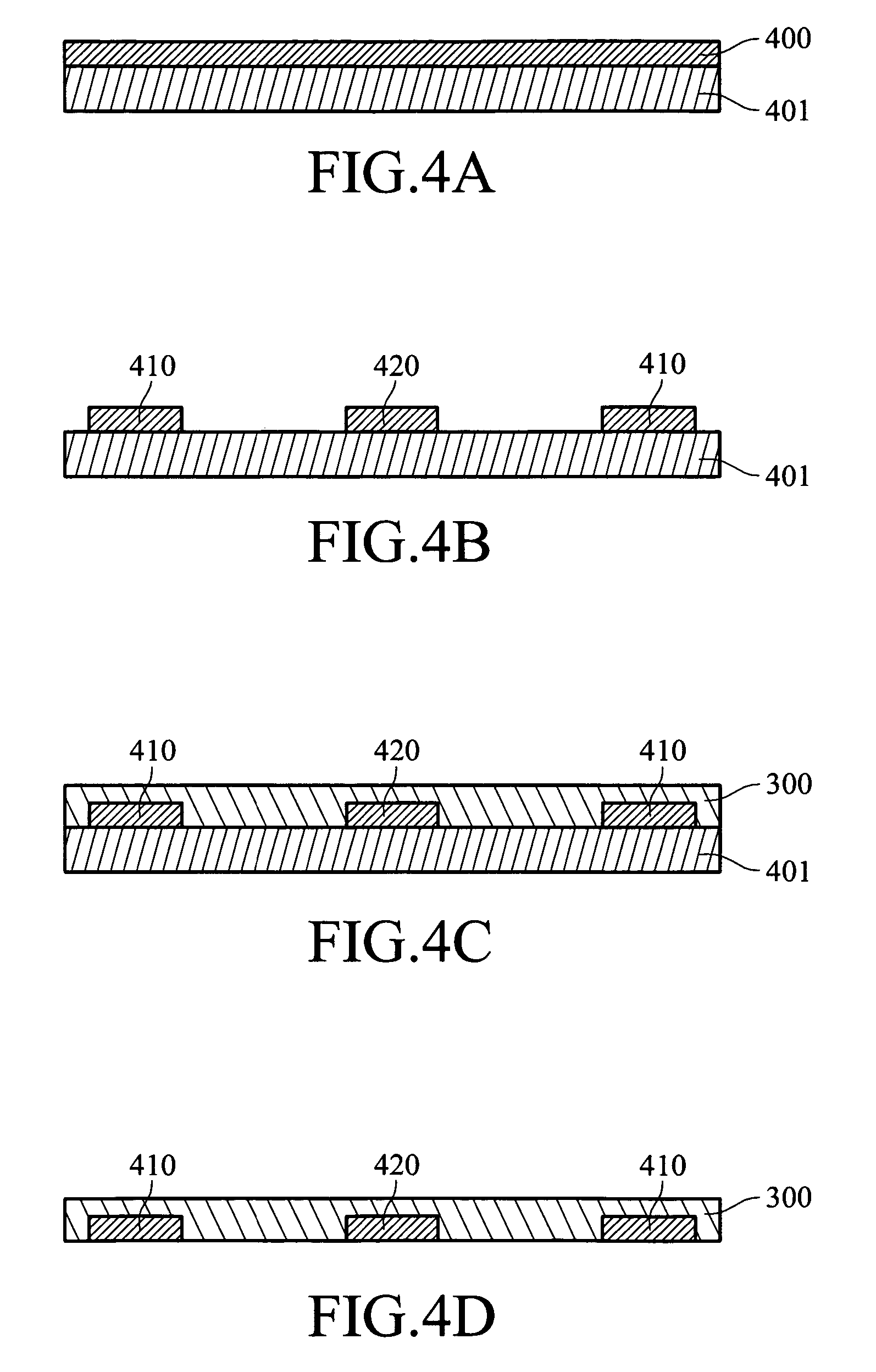Bonding structure of device packaging
a technology of device packaging and bonding structure, which is applied in the direction of transportation and packaging, coatings, chemistry apparatuses and processes, etc., can solve the problems of bridging phenomena, significant difference in device thermal expansion coefficient between adhesive agent and substrate, and likely generation of thermal stress deformation, so as to reduce the required bonding temperature, increase the bonding density, and increase the effect of fabrication reliability
- Summary
- Abstract
- Description
- Claims
- Application Information
AI Technical Summary
Benefits of technology
Problems solved by technology
Method used
Image
Examples
first embodiment
[0019]Please refer to FIG. 1 for a detailed description of the invention. As shown in the drawing, the invention contains a first substrate 100 and a second substrate 200. The first substrate 100 has several metal pads 110, adhesive metal circuit layers 120, a passivation layer 140, and a first bonding metal layer 130. In addition, the first substrate 100 has a first surface with a first center area, the several metal pads 110 are located on the first surface outside the first center area, and the first bonding metal layer 130 is located on the first center area. As can be seen in FIG. 1, the adhesive metal circuit layers 120 have a same height as that of the first bonding metal layer 130. Moreover, the adhesive metal circuit layers 120 have areas facing the second substrate and corresponding to the respective metal pads 110. The areas are larger than areas of the metal pads 110 confronting the adhesive metal circuit layers 120. The passivation layer 140 is formed on the surface of ...
second embodiment
[0020]The metal pads on the first substrate are connected to the electrodes on the second substrate using the extension of the adhesive circuit on the first substrate. With reference to FIG. 2, the invention also contains a first substrate 100 and a second substrate 200. A surface of the first substrate 100 has several metal pads 110, an adhesive metal circuit 120, a passivation layer 140, and a first bonding metal layer 130. The passivation layer 140 is formed on the surface of the first substrate 110, exposing the metal pads 110. The adhesive metal circuit 120 is connected to the metal pads 110 and extends to cover the passivation layer 140. The first bonding metal layer 130 covers the passivation layer 140. A surface of the second substrate 200 has several electrodes 210 and a second bonding metal layer 220. The first substrate 100 is bonded with the second substrate 120 in such a way that the first bonding metal layer 130 is fixed onto the second bonding metal layer 220. The met...
third embodiment
[0021]Moreover, the invention can embed the electrodes 210 and the second bonding metal layer 220 into the second substrate 200, exposing only their top surfaces. A cross-sectional view of the third embodiment is shown in FIG. 3. It includes a first substrate 100 and a second substrate 200. The structure of the first substrate 100 is as described before. The electrodes 210 and the second bonding metal layer 220 installed on the surface of the second substrate 200 are embedded into the second substrate 200, exposing only their top surfaces. The first substrate 100 is bonded with the second substrate 200 surface to surface, so that the first bonding metal layer 130 is fixed onto the second bonding metal layer 220. The bonding border of the first and second substrates 100, 200 is filled with some adhesive agent 230. Using the embedded second substrate structure, the packaging volume can be further reduced.
[0022]In particular, the embedded substrate can be prepared using the following s...
PUM
| Property | Measurement | Unit |
|---|---|---|
| areas | aaaaa | aaaaa |
| bonding structure | aaaaa | aaaaa |
| adhesive | aaaaa | aaaaa |
Abstract
Description
Claims
Application Information
 Login to View More
Login to View More - R&D
- Intellectual Property
- Life Sciences
- Materials
- Tech Scout
- Unparalleled Data Quality
- Higher Quality Content
- 60% Fewer Hallucinations
Browse by: Latest US Patents, China's latest patents, Technical Efficacy Thesaurus, Application Domain, Technology Topic, Popular Technical Reports.
© 2025 PatSnap. All rights reserved.Legal|Privacy policy|Modern Slavery Act Transparency Statement|Sitemap|About US| Contact US: help@patsnap.com



